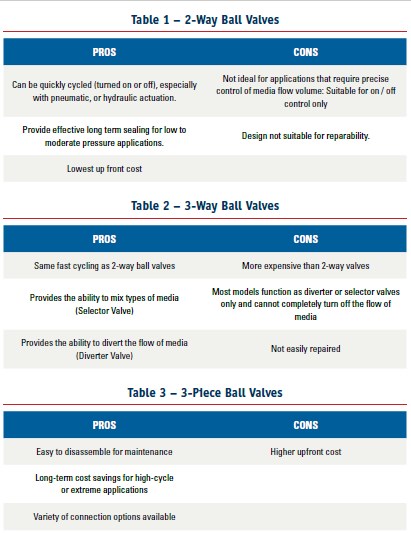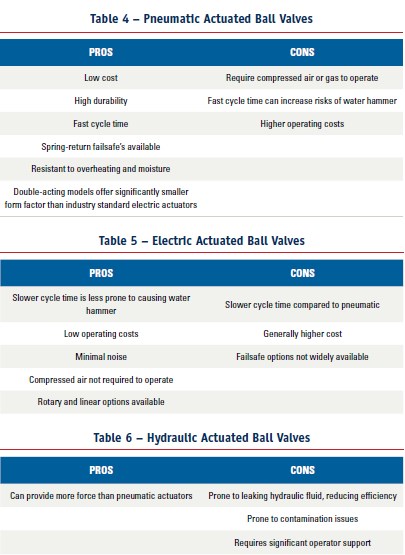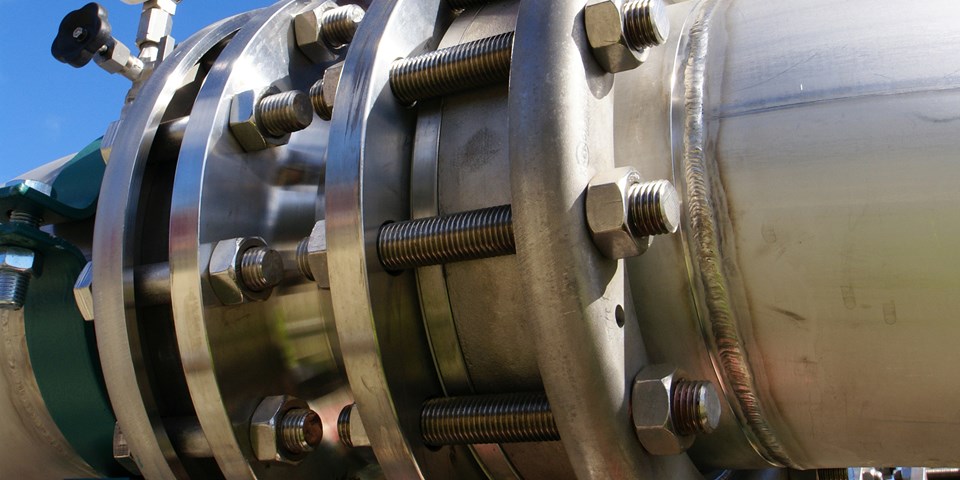By George Packard – Gemini Valve
The key features and specifications of each ball valve type are designed to meet a multitude of unique needs among a wide variety of industries. In this article, we cover everything you need to know to ensure that your projects are executed with the right type of valve for operational efficiency.
How Ball Valves Work
Before we dive into the pros and cons of the various types of ball valves, let us briefly discuss how a ball valve works.
A ball valve is a quarter turn valve that uses a ball with a hole drilled through it to control the flow of media. The hole is referred to as the port or orifice and, when opened, it aligns with the valve body to permit flow. The ball is contained within the valve body and is held in place by two cup shaped seals commonly referred to as seats. To allow media to flow through the valve, the ball is rotated 90 degrees so that the port is aligned parallel to the valve body. To turn off flow, the ball is rotated back so that the port is perpendicular to the valve body. These rotations (known as cycles) can be triggered by a manual operator (usually a lever handle), or automatically through the use of a pneumatic, electric or hydraulic actuator.

Ball Valves by Circuit Function
2-Way Ball Valves
Two-way ball valves are used for traditional on/off control and are the most commonly used type of ball valve. These valves are ideal for a wide variety of OEM and end-user applications, including testing, fluid filling, batching and draining. (Table 1)
3-Way Ball Valves
Three-way ball valves are the most popular type of multi-port ball valve. This style of valve is commonly used in applications with more than one source of media or to divert media in two different directions. Depending on the flow direction, the three ports are assigned as either one outlet and two inlets, or one inlet and two outlets. They are designed for applications such as process control, sterilizers/autoclaves and bottling and dispensing. (Table 2)
3-Piece Ball Valves
A 3-piece ball valve features a main body and two pipe connectors, which are threaded or welded to a pipe. This design allows the valve to be taken apart and repaired without removing the pipe connectors from the plumbing. Three-piece ball valves are ideal for high-cycle and/or heavy pressure applications that experience a lot of wear and tear. (Table 3)

Ball Valve Actuation Types
All ball valves are powered manually or through automated energy sources. Actuators are mounted to the valve stem and work as control mechanisms to open or close the valve. With the appropriate power source for your project, you can reduce maintenance costs, increase uptime and maximize safety
Pneumatic Actuated Ball Valves
Pneumatic ball valves use compressed air to automate the control of media. Pneumatic actuated ball valves are commonly used on OEM equipment where compressed air is accessible, such as liquid filling equipment or automotive fluid fill systems. They are also found in factories and manufacturing facilities. (Table 4)
Additional Key Considerations for Pneumatic Valve Actuators
• Power Source: Require a compressed air supply
• Speed: To open or close the valve, pneumatic actuators take half a second to one full second, depending on the model
• Durability: High quality pneumatic actuators can last for up to cycle counts of 1,000,000 +/- when used within specifications. Spring-return models are less durable due to spring fatigue.
• Safety Features: Double-acting models provide failsafe in event of power failure. Spring-return models provide failsafe for both power and compressed air failure
Electric Actuated Ball Valves
Also known as motorized ball valves, electric actuated ball valves are the most popular choice for ball valve automation. This form of ball valve uses an electric motor to operate the ball valve and control the flow of media. Electric actuated ball valves are used by OEMs, as well as for industrial and commercial applications. (Table 5)
Additional Key Considerations for Electric Valve Actuators
• Voltages: Most electric actuators are available in a wide variety of voltages.
• Durability: High quality electric actuators can be extremely durable but are not likely to last as long as pneumatic actuators.
• Speed/Torque Options: Most electric actuators take approximately six seconds to open/close the valve. The exact time will depend on the manufacturer.
• Protection Ratings: The National Electrical Manufacturers Association (NEMA) sets guidelines for the use of electric products in certain environments. Below are four of the most common ratings for electric actuators:
-NEMA 4: Weatherproof, for indoor and outdoor use. This rating defines the necessary protection needed against water, dirt and ice.
-NEMA 4X: This rating follows the NEMA 4 guidelines with added protection from corrosion.
-NEMA 6: For submersible use in water, quarries and mines. The exact design depends on the specific pressure and time the product is submerged.
-NEMA 7: For indoor use in hazardous areas. This rating means products are capable of withstanding pressure from internal explosions.
Hydraulic Actuated Ball Valves
Hydraulic actuators are similar to pneumatic devices, only they use pressurized fluid instead of air or gas. The fluid — either water or oil — is fed to one or both sides of a piston to create movement. Hydraulic actuators can provide significantly more force / speed than pneumatic actuators due the use of uncompressible fluid in the place of compressed air. (Table 6)
Due to their versatile nature, ball valves are one of the most widely used industrial equipment in existence. Each ball valve type has advantages and drawbacks to consider when selecting the right option for your intended application. It’s best to first determine your invariable needs and then decide what additional features will best suit your application.

Steps to Ball Valve Selection
Now that you’ve learned the pros and cons of each ball valve type, it’s time to bring it all together and select the right one for your needs. Wondering where to start? Follow these steps to select the ideal ball valve for your operation.
Step 1: Valve Design
Ball valves are available with a variety of body and flow pattern designs. The design you choose should be based on application media compatibility, pressure and temperature compatibility, required design features (such as repairability), and desired flow pattern. Choosing the correct valve design for your specific application should be your first decision as this will impact many of the options and features available for the remaining components in the assembly.
Step 2: Operation Type
There are two options when it comes to selecting the operation type: manual or automatic. Here are some of the reasons to choose one or the other.
When to use a manual ball valve:
• Infrequent cycling
• Low budget
• No electricity/compressed air at installation
• Valve is in an accessible location for operators to reach
When to use an automatic ball valve:
• Automation is needed
• Ball valve will be cycled too frequently for manual operation to be practical
• Ball valve is in a location that is not accessible for manual operation
• Valve requires failsafe feature
• Larger size valve that cannot be turned by hand
If you do choose to go with an automated valve, it is important to choose the right actuator type for your application.
Step 3: Body Material
It is important to select a body type material that is compatible with the form of media being used. Selecting the right material will allow for less maintenance and will in turn lower your costs. The most common materials include:
• Brass: Used for neutral and non-corrosive media and is resistant to high temperatures
• Stainless Steel: Used for general chemical resistance. For extremely corrosive medias, more resistant metals such as Monel, or Alloy-20 may be required to ensure compatibility.
• PVC: Used for corrosive media such as salt water or solvents and is resistant to high temperatures. PVC valves are generally much less durable than metal valves.
Step 4: Seal Materials
The most popular seal material for ball valves is P.T.F.E., a thermoplastic that is chemically inert which makes it chemically compatible with nearly any media type. For applications with extreme pressure or temperature, alternative seal materials may be required.
Some ball valve designs include additional seal materials such as elastomer O-rings or gaskets. Care must be taken to ensure all components used in the valve design are compatible with the media used in your application.
Step 5: Hole Design
The hole in the ball can be designed using three different profiles:
• Full Bore: Bore diameter is the same diameter as the pipe
• Standard Bore: Smaller diameter than a full bore that may reduce flow rate depending on the system.
• V-Shaped Port: Can more precisely control flow rate when rotating the ball
• Vented: Small hole drilled into the upstream side to eliminate unwanted pressure within the valve
Step 6: Safety Standards
Safety is of the utmost importance in any industry. Be sure that the ball valve you select is compatible with your application. Look for a manufacturer that 100% tests their valves for both proper functionality and leak tight performance. If you are unsure, reach out to the manufacturer directly to learn more about how their products will perform in your equipment or application.
From home applications to specialized industries, ball valves ball valves perform an integral role in many essential processes. Their compact, economical designs are bringing versatility and durability to a range of industrial applications – and as technology continually progresses, ball valve capability is only scratching the surface of what is yet to come.
About the Author
George Packard is the Vice President of Marketing at Gemini Valve, a family-owned American manufacturer of automated and manual ball valves. Established in 1974, Gemini Valve has years of experience in valve design and manufacturing to provide reliable solutions for any type of application.


